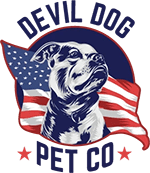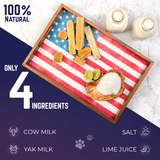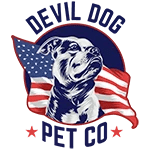What Is Beef Dog Food?
When you're scanning the pet food aisle, beef dog food stands out as one of the most popular protein choices—and for good reason. This isn't just marketing hype; beef delivers a nutritional powerhouse that aligns perfectly with your dog's biological needs as a carnivore.
Key Takeaways
- Beef dog food is a protein-rich diet with beef as the main ingredient, providing essential amino acids, vitamins, minerals, and healthy fats.
- It is available in various formats including dry, wet, raw, and freeze-dried to suit different feeding preferences.
- Quality beef dog food supports muscle development, energy metabolism, and overall canine health.
- Choosing beef sourced from grass-fed cattle and formulated to AAFCO standards ensures optimal nutrition for dogs.
- Beef is a popular and nutritionally suitable protein choice that aligns with a dog's carnivorous dietary needs.
Table of Contents
- What Is Beef Dog Food?
- The Nutritional Power of Beef for Dogs
- Sourcing & Quality: Grass-Fed vs. Conventional Beef
- Beef Dog Food Across Life Stages
- Choosing Quality Commercial Beef Dog Food
- Homemade Beef Dog Food: Recipes & Best Practices
- Raw vs. Cooked Beef Dog Food: Making the Right Choice
- Addressing Common Beef Dog Food Concerns
- Is Beef Dog Food Right for Your Dog?
Beef dog food uses beef as the primary protein source, typically appearing as the first ingredient on quality formulations. You'll find it in multiple formats: dry dog food with beef, wet canned varieties, freeze-dried options, and even air dried beef preparations that concentrate nutrients while maintaining palatability.
Unlike chicken or fish-based diets, beef provides a robust amino acid profile that supports everything from puppy growth spurts to senior muscle maintenance. The protein density in quality beef dry dog food typically ranges from 22-32%, making it ideal for active dogs, working breeds, and any pup needing sustained energy.
Here's what separates premium beef dog food from the pack: sourcing matters. Grass-fed, grass-finished beef contains higher levels of omega-3 fatty acids and conjugated linoleic acid (CLA) compared to grain-fed alternatives. When you see "grass-fed beef" listed prominently, you're looking at a formula designed for optimal nutrition, not just palatability.
The processing method also impacts nutritional value. Air dried meat preparations preserve more nutrients than traditional kibble processing, while air dried meats in treats and toppers add concentrated protein without fillers. This gentle dehydration process maintains the meat's natural enzyme activity and bioavailability.
Modern beef dog food dry formulations often combine multiple beef sources—muscle meat, organ meat, and sometimes bone meal—to create a complete amino acid profile. One standout addition is beef heart, a nutrient-dense muscle meat rich in taurine and CoQ10 that supports cardiovascular health and energy metabolism in dogs. Premium brands source from USDA-inspected facilities and maintain strict quality control from ranch to bowl.
But beef dog food isn't just about protein content. Quality formulations include the supporting cast your dog needs: prebiotics for digestive health, omega fatty acids for coat shine, and chelated minerals for maximum absorption. The best beef dog foods read like a complete nutrition plan, not just a protein delivery system.
Whether you're considering a switch to beef-based nutrition or evaluating your current choice, understanding these fundamentals sets the foundation for making an informed decision. Your dog's energy levels, coat quality, and overall vitality depend on getting this protein choice right.
The key is matching the right beef dog food format to your dog's life stage, activity level, and individual needs. A working dog requires different nutritional density than a couch-loving senior, and quality beef-based diets can accommodate both extremes when properly selected.
The Nutritional Power of Beef for Dogs

When you choose beef as your dog's primary protein source, you're delivering far more than just calories. Quality beef provides a complete nutritional foundation that supports every system in your dog's body, from cellular repair to cognitive function.
Complete Protein Profile: All Essential Amino Acids
Beef delivers all nine essential amino acids dogs cannot produce on their own, making it a complete protein source. This amino acid profile includes leucine for muscle protein synthesis, lysine for calcium absorption, and methionine for healthy coat development.
The biological value of beef protein—how efficiently your dog's body can use it—ranks among the highest of all protein sources. This means less waste, better utilization, and more support for muscle maintenance, tissue repair, and immune function.
Vitamin Powerhouse: B-Complex and Beyond
Beef naturally contains concentrated levels of B-vitamins that directly impact your dog's energy metabolism and nervous system function:
- Vitamin B12 (Cobalamin): Essential for red blood cell formation and neurological function
- Niacin (B3): Supports healthy skin, coat, and digestive system
- Riboflavin (B2): Critical for energy production and cellular growth
- Vitamin B6: Aids in amino acid metabolism and neurotransmitter production
These vitamins work synergistically, meaning they're more effective together than individually. This natural combination in beef provides superior bioavailability compared to synthetic vitamin supplements added to lower-quality foods.
Essential Minerals: Iron, Zinc, and More
Beef's mineral profile addresses common deficiencies that can impact your dog's health and vitality. The standout minerals include:
Heme Iron: Unlike plant-based iron sources, beef provides heme iron—the most bioavailable form for dogs. This supports oxygen transport, energy levels, and prevents anemia, especially crucial for active dogs and growing puppies.
Zinc: Critical for immune function, wound healing, and coat quality. Beef provides zinc in a highly absorbable form that supports skin health and reduces inflammation.
Selenium: Acts as a powerful antioxidant, protecting cells from oxidative damage and supporting thyroid function.
Phosphorus: Works with calcium for bone health and energy metabolism, particularly important for large breed development.
Healthy Fats: Omega-3 and Omega-6 Balance
Quality beef, especially from grass-fed sources, provides an optimal balance of omega-3 and omega-6 fatty acids. This balance directly impacts:
- Coat shine and skin health
- Anti-inflammatory response
- Cognitive function and brain development
- Joint health and mobility
Grass-fed beef contains up to five times more omega-3 fatty acids than grain-fed alternatives, making sourcing a critical factor in nutritional quality.
Caloric Density and Natural Energy
Beef provides concentrated energy in a bioavailable form, making it ideal for active dogs, working breeds, and dogs recovering from illness or surgery. The caloric density varies by cut and preparation method, but quality beef dog foods typically provide 350-450 calories per cup.
Organ meats like liver boost this nutritional profile even further, providing concentrated vitamins A, D, and additional B-vitamins. Many premium beef dog foods include organ meat to maximize nutritional density without increasing volume.
This nutritional foundation explains why beef remains a top choice for performance dogs, growing puppies, and any dog requiring sustained energy and optimal nutrition. The key is selecting beef dog food that preserves these nutrients through proper sourcing and processing methods.
Sourcing & Quality: Grass-Fed vs. Conventional Beef
Not all beef is created equal, and the sourcing decisions made by dog food manufacturers directly impact the nutritional value your dog receives. Understanding the difference between grass-fed and conventional beef can help you make informed choices that support your dog's long-term health.
Grass-Fed, Grass-Finished: The Gold Standard
Grass-fed, grass-finished beef comes from cattle that graze on pasture their entire lives, never receiving grain-based feed. This natural diet creates a superior nutritional profile that translates directly to your dog's bowl.
The omega-3 fatty acid content in grass-fed beef is up to five times higher than conventional beef, while maintaining a healthier omega-6 to omega-3 ratio. This balance reduces inflammation and supports immune function, joint health, and cognitive development.
Grass-fed beef also contains higher levels of conjugated linoleic acid (CLA), a beneficial fatty acid linked to improved body composition and immune support. For active dogs or those recovering from illness, these enhanced fatty acid profiles provide measurable health benefits.
Conventional Beef: Understanding the Trade-offs
Conventional beef comes from cattle finished on grain-based diets, typically corn and soy. While still providing complete protein and essential nutrients, the fatty acid profile shifts toward higher omega-6 content and lower beneficial compounds.
Quality conventional beef can still support excellent canine health when sourced from reputable suppliers who maintain strict quality standards. The key is ensuring the beef comes from USDA-inspected facilities with transparent supply chains.
Many premium dog food brands use conventional beef but supplement with additional omega-3 sources like fish oil or flaxseed to balance the fatty acid profile. This approach can deliver excellent nutrition at a more accessible price point.
Grass-Fed Beef Pros
- Higher omega-3 fatty acid content
- Better omega-6 to omega-3 ratio
- Increased CLA and antioxidants
- No grain-based feed additives
- More sustainable farming practices
Grass-Fed Beef Cons
- Higher cost for dog food formulations
- Limited availability in some regions
- Seasonal nutritional variations
- May require supplementation for complete nutrition
Why Sourcing Transparency Matters
Premium dog food manufacturers provide detailed sourcing information, including ranch locations, processing facilities, and quality control measures. This transparency allows you to evaluate the true quality of the beef in your dog's food.
Look for brands that specify "grass-fed, grass-finished" rather than just "grass-fed," as cattle can be grass-fed initially but grain-finished, which changes the nutritional profile. Similarly, "pasture-raised" doesn't guarantee the same nutritional benefits as grass-finished beef.
Regional sourcing also impacts quality and sustainability. Beef sourced from American ranches typically follows stricter quality standards than imported alternatives, while supporting local agricultural communities.
Beef Dog Food Across Life Stages

Your dog's nutritional needs evolve throughout their life, and quality beef dog food can support optimal health from puppyhood through senior years. Understanding how to adjust beef-based nutrition for each life stage ensures your dog receives appropriate protein levels and supporting nutrients.
Puppies: Supporting Rapid Growth and Development
Growing puppies require higher protein levels than adult dogs—typically 22-32% protein content in their food. Beef provides the complete amino acid profile necessary for muscle development, bone growth, and organ formation during this critical period.
The high biological value of beef protein means puppies can efficiently convert dietary protein into body tissue, supporting healthy weight gain without excess fat accumulation. Large breed puppies particularly benefit from beef's balanced amino acid profile, which supports controlled growth rates that prevent developmental orthopedic diseases.
Puppy-specific beef formulations often include higher fat content (8-15%) to support brain development and energy needs. The DHA naturally present in grass-fed beef supports cognitive development and trainability during the crucial early months.
Adult Dogs: Maintenance and Peak Performance
Adult dogs thrive on beef-based diets that provide 18-25% protein content, depending on activity level. Working dogs, sporting breeds, and highly active dogs benefit from the higher end of this range, while less active dogs maintain excellent health with moderate protein levels.
Beef's sustained energy release makes it ideal for dogs with demanding exercise routines. The combination of complete proteins and healthy fats provides steady energy without the spikes and crashes associated with high-carbohydrate diets.
Adult dogs also benefit from beef's mineral profile, particularly iron and zinc, which support immune function and coat quality during their prime years. The B-vitamin complex in beef supports energy metabolism and nervous system function throughout their active adult life.
Senior Dogs: Maintaining Vitality and Health
Senior dogs face unique nutritional challenges, including decreased muscle mass, reduced digestive efficiency, and increased risk of anemia. Beef dog food addresses these concerns through highly digestible protein and bioavailable nutrients.
The heme iron in beef is particularly valuable for senior dogs, as it prevents age-related anemia more effectively than plant-based iron sources. This supports energy levels and cognitive function in older dogs who may be experiencing decreased vitality.
Senior-specific beef formulations often include added glucosamine and chondroitin, compounds that work synergistically with beef's natural collagen to support joint health and mobility. The anti-inflammatory properties of grass-fed beef's omega-3 content also help manage age-related inflammation.
Digestibility becomes crucial for senior dogs, and beef's high biological value means less digestive work for the same nutritional benefit. This reduces stress on aging digestive systems while maintaining muscle mass and overall health.
Choosing Quality Commercial Beef Dog Food
Navigating the commercial dog food market requires understanding how to evaluate quality, read ingredient labels effectively, and identify formulations that deliver on their nutritional promises. The right commercial beef dog food can provide complete, balanced nutrition that rivals homemade diets.
How to Read Ingredient Labels Like a Pro
The ingredient list tells the complete story of what your dog is actually eating. Quality beef dog foods list specific meat sources as the first ingredient—look for "deboned beef," "beef meal," or "grass-fed beef" rather than generic terms like "meat" or "animal protein."
Beef meal deserves special attention. This concentrated protein source contains 65-75% protein compared to fresh beef's 18-25%. When beef meal appears as the second or third ingredient after fresh beef, it indicates a protein-dense formulation that maintains high meat content after processing.
Avoid formulations with excessive fillers, artificial preservatives, or unnamed meat by-products. Quality beef dog foods use recognizable ingredients: sweet potatoes, peas, carrots, and named vitamins and minerals rather than chemical-sounding additives.
Avoiding Fillers and Artificial Additives
Premium beef dog foods minimize fillers like corn, wheat, and soy that provide calories without significant nutritional value. Instead, they use nutrient-dense carbohydrates like sweet potatoes, lentils, and chickpeas that contribute vitamins, minerals, and fiber.
Artificial preservatives like BHA, BHT, and ethoxyquin have no place in quality dog food. Look for natural preservation methods using mixed tocopherols (vitamin E), rosemary extract, or other natural antioxidants that maintain freshness without health concerns.
Artificial colors and flavors indicate a focus on marketing rather than nutrition. Dogs don't care about food color, and quality beef provides natural palatability without artificial flavor enhancers.
The Importance of Sourcing Transparency
Reputable manufacturers provide detailed information about their beef sources, including ranch locations, processing facilities, and quality control measures. This transparency allows you to evaluate the true quality behind marketing claims.
Look for specific sourcing statements like "grass-fed beef from American ranches" or "USDA-inspected facilities" rather than vague terms like "premium beef" or "high-quality protein." Companies confident in their sourcing practices readily share this information.
Third-party certifications add credibility to sourcing claims. Certifications from organizations like the American Grassfed Association or USDA Organic provide independent verification of sourcing and processing standards.
Manufacturing location matters too. Dog foods produced in facilities with strong regulatory oversight and quality control systems provide greater assurance of consistent quality and safety standards.
The best commercial beef dog foods combine transparent sourcing with rigorous quality control, creating formulations that deliver consistent nutrition your dog can thrive on. When manufacturers invest in quality ingredients and transparent practices, it shows in your dog's energy, coat condition, and overall vitality.
Homemade Beef Dog Food: Recipes & Best Practices

Creating homemade beef dog food gives you complete control over ingredients and quality while potentially saving money compared to premium commercial options. However, success requires understanding proper nutrition balance, safe preparation methods, and storage practices that maintain freshness and prevent contamination.
Step-by-Step Homemade Beef Dog Food Recipe
This balanced recipe provides complete nutrition for adult dogs when prepared correctly. Always consult your veterinarian before switching to homemade diets, especially for puppies, seniors, or dogs with health conditions.
Basic Homemade Beef Dog Food Recipe
Ingredients: 2 lbs ground beef (80/20 lean-to-fat ratio), 1 cup brown rice, 1 cup sweet potato (diced), 1/2 cup carrots (chopped), 1/2 cup green beans, 2 eggs, 1 tablespoon olive oil, 1/4 teaspoon dried rosemary
Yield: Approximately 6 cups, feeding a 50-lb dog for 3-4 days
Start by browning the ground beef in a large pot over medium heat, breaking it into small pieces as it cooks. Cook thoroughly until no pink remains—this eliminates harmful bacteria like E. coli and Salmonella that can cause serious illness in dogs.
Add the diced sweet potato and chopped carrots to the pot, followed by 3 cups of water. Bring to a boil, then reduce heat and simmer for 15 minutes until vegetables begin to soften. The sweet potato provides beta-carotene and fiber, while carrots add natural sweetness and additional vitamins.
Stir in the brown rice and continue simmering for another 20 minutes until the rice is tender and has absorbed most of the liquid. Brown rice provides sustained energy and essential B vitamins while being gentler on digestion than white rice.
Add the green beans during the final 5 minutes of cooking—they should remain slightly crisp to provide texture and maintain maximum nutrient content. Remove from heat and let cool for 10 minutes before stirring in the beaten eggs and olive oil.
Safe Preparation and Storage Practices
Food safety becomes critical when preparing homemade dog food. Use separate cutting boards and utensils for raw meat, wash hands thoroughly between handling steps, and maintain proper cooking temperatures throughout the process.
Cool the finished food quickly by dividing it into smaller containers and refrigerating immediately. Homemade beef dog food stays fresh for 3-4 days in the refrigerator or up to 3 months when frozen in portion-sized containers.
Portion the food based on your dog's daily caloric needs—typically 25-30 calories per pound of body weight for moderately active adult dogs. This recipe provides approximately 400 calories per cup, making portion control straightforward.
Ensuring Complete Nutrition
Homemade diets require careful attention to nutritional balance. While this recipe provides excellent protein and carbohydrates, it may need supplementation with calcium, omega-3 fatty acids, and certain vitamins to meet all nutritional requirements.
Consider adding a canine vitamin and mineral supplement designed for homemade diets, or consult with a veterinary nutritionist to ensure your recipe meets AAFCO standards for complete and balanced nutrition.
Monitor your dog's weight, energy levels, and coat condition closely during the transition to homemade food. These indicators will help you adjust portions and ingredients to optimize the diet for your individual dog's needs.
Raw vs. Cooked Beef Dog Food: Making the Right Choice
The debate between raw and cooked beef for dogs involves weighing potential nutritional benefits against safety considerations. Both approaches can support excellent canine health when executed properly, but each requires different handling protocols and suits different lifestyles.
Raw Beef: Benefits and Considerations
Raw beef proponents argue that cooking destroys certain enzymes and heat-sensitive nutrients that benefit canine health. Raw beef maintains its natural moisture content and may be more palatable for picky eaters who prefer the texture and flavor of uncooked meat.
However, raw beef carries inherent risks including bacterial contamination from E. coli, Salmonella, and other pathogens. These risks extend beyond the dog to human family members, particularly children, elderly individuals, and immunocompromised people who may be exposed through cross-contamination.
If choosing raw beef, source from reputable suppliers who follow strict handling protocols, freeze the meat for at least 24 hours to reduce parasite risk, and maintain rigid food safety practices throughout preparation and feeding.
Cooked Beef: Safety and Digestibility
Cooking beef eliminates harmful bacteria while maintaining most nutritional benefits. The cooking process breaks down tough protein fibers, making the meat more digestible for dogs with sensitive stomachs or compromised digestive systems.
Cooked beef also offers practical advantages: easier storage, reduced contamination risk, and greater flexibility in meal preparation. Most dogs readily accept cooked beef, and the cooking process allows for better integration with other ingredients.
The key is avoiding overcooking, which can reduce protein quality and create tough, less palatable meat. Gentle cooking methods like simmering or slow-cooking preserve nutrients while ensuring safety. For a deeper dive into the science behind pet diets, see this OSU research on healthier options for pet diets.
Addressing Common Beef Dog Food Concerns
Even quality beef dog food can present challenges for some dogs. Understanding how to identify and address common issues ensures your dog receives maximum benefit from their beef-based diet while maintaining optimal health and comfort.
Recognizing Beef Allergies and Sensitivities
True beef allergies in dogs are relatively uncommon, affecting approximately 3-5% of dogs with food allergies. However, beef sensitivity can develop over time, particularly in dogs with compromised immune systems or those exposed to low-quality beef products.
Common signs of beef intolerance include chronic ear infections, skin irritation, excessive scratching, digestive upset, and changes in stool consistency. These symptoms typically appear within hours to days of eating beef and persist until the protein is eliminated from the diet.
If you suspect beef sensitivity, work with your veterinarian to conduct an elimination diet trial. This involves feeding a novel protein source for 8-12 weeks, then reintroducing beef to confirm the reaction. Proper diagnosis prevents unnecessary dietary restrictions while identifying true problem ingredients.
Managing Digestive Transitions
Switching to beef dog food requires gradual transition to prevent digestive upset. Mix increasing amounts of the new beef food with decreasing amounts of the current food over 7-10 days, allowing your dog's digestive system to adapt to the new protein source.
Some dogs may experience temporary loose stools during the transition period. This is normal and typically resolves within a few days as the digestive system adjusts. However, persistent diarrhea, vomiting, or signs of distress warrant immediate veterinary attention.
Adding probiotics during the transition can support digestive health and reduce the likelihood of upset. Many dogs benefit from a high-quality probiotic supplement designed specifically for canines during dietary changes. For more information on healthy dog snacking, check out this guide on single ingredient dog treats.
Is Beef Dog Food Right for Your Dog?
Beef dog food offers exceptional nutritional value for most dogs when sourced responsibly and formulated properly. The complete amino acid profile, high biological value protein, and rich mineral content make beef an excellent foundation for canine nutrition across all life stages.
The decision between commercial and homemade beef dog food depends on your time availability, budget, and comfort level with nutritional planning. Premium commercial options provide convenience and guaranteed nutritional balance, while homemade diets offer complete ingredient control and potential cost savings.
Success with beef dog food requires attention to quality sourcing, proper preparation methods, and ongoing monitoring of your dog's response. Whether you choose grass-fed commercial formulations or prepare homemade meals, the key is consistency in quality and appropriate portion control.
Remember that individual dogs may respond differently to beef-based diets. Monitor your dog's energy levels, coat condition, digestive health, and overall vitality as indicators of nutritional success. When beef dog food is properly implemented, most dogs experience improved muscle development, enhanced coat quality, and sustained energy levels that support an active, healthy lifestyle.
The investment in quality beef dog food pays dividends in your dog's long-term health, vitality, and quality of life. Choose wisely, transition gradually, and enjoy watching your dog thrive on the nutritional foundation that quality beef provides. For medium-sized breeds, explore our 20-45 lbs product selection, or consider the 12" Braided Bully Stick - 3pk for a high-protein, single-ingredient treat. For larger breeds, the 12" Ultra Thick Bully Stick - 6pk offers a long-lasting, satisfying chew. For further reading, see this peer-reviewed study on canine nutrition.
Download the FREE 10-Step Dog Prep Guide
Frequently Asked Questions
Is beef-based dog food good for dogs?
Beef is a high-quality protein source rich in essential amino acids, iron, and B vitamins that support muscle maintenance, energy, and overall health in dogs. When sourced responsibly and balanced with other nutrients, beef-based dog food can be a great choice, especially for active or working dogs who need sustained energy.
Is beef better for dogs than chicken?
Neither beef nor chicken is universally better—it depends on your dog’s individual needs, sensitivities, and preferences. Beef tends to be richer and higher in iron and fat, which can benefit dogs with higher energy demands, while chicken is leaner and often easier to digest. Rotating proteins or choosing one based on your dog's digestive tolerance and activity level is the smart call.
Are beef good for dogs?
Yes, beef provides essential nutrients like protein, iron, zinc, and B vitamins critical for your dog’s muscle health, immune function, and energy metabolism. However, quality matters—opt for beef that’s free from fillers, hormones, and unnecessary additives to ensure your dog gets the full benefit without digestive upset.
Which is better for dogs, salmon or beef?
Both salmon and beef bring unique benefits: salmon offers omega-3 fatty acids that reduce inflammation and support skin and coat health, while beef delivers robust protein and minerals for muscle and blood health. For dogs with allergies or skin issues, salmon may be preferable; for general strength and stamina, beef shines. A balanced diet that includes both can cover the bases.
What is the 1 meat dogs should avoid?
Raw or undercooked pork is generally the meat dogs should avoid due to the risk of parasites like trichinella and bacteria that can cause serious illness. Properly cooked pork is safer, but many vets recommend sticking with more digestible and safer proteins like beef, chicken, or fish to minimize risk.
Is turkey or beef better for dogs?
Turkey is leaner and lower in fat, making it a solid choice for dogs needing weight management or with sensitivities, while beef is richer and higher in iron and calories, suitable for active dogs needing more energy. Both are excellent protein sources; your choice should align with your dog’s health status, energy needs, and taste preference.






